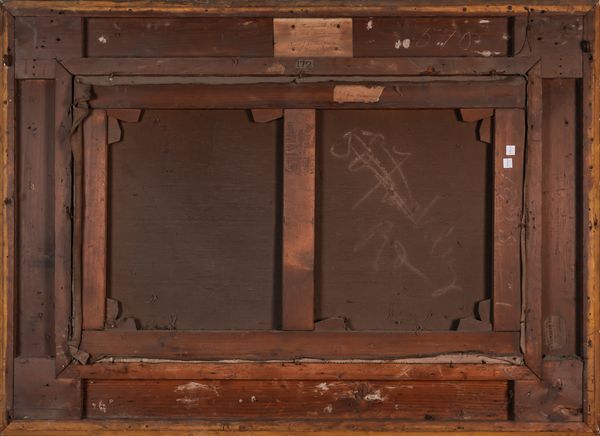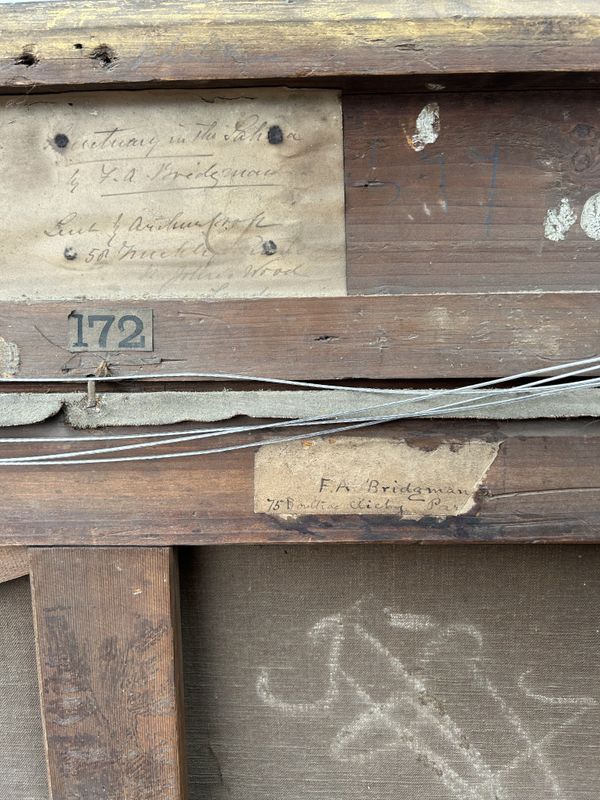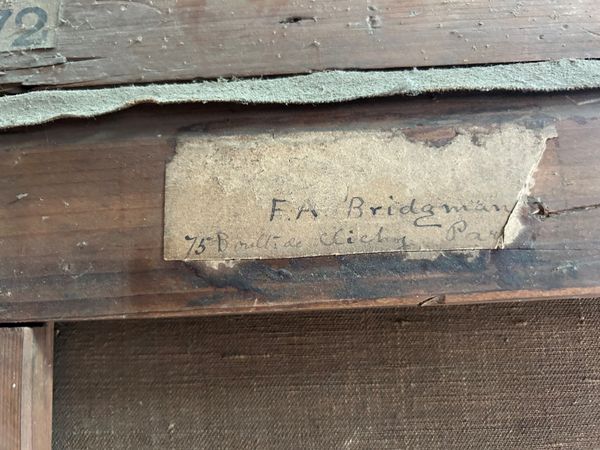FREDERICK ARTHUR BRIDGMAN (AMERICAN, 1847-1928)
Sanctuary in the Sahara
signed and dated ‘F. A Bridgman 1879’ (lower left)
oil on canvas
56 x 87cm
Provenance
The artist Arthur Croft (1828-1902);
Thence by family descent to the current owner
Exhibited
London, Royal Academy, Annual, 1880, no. 232
Literature
For a related work see;
Frederick A. Bridgman, Winters in Algeria (New York: Harper and Brothers, 1890), drawing, Mosque of Lichana, repro. p. 248.
The present work will be on view at Cromwell Place SW7 on 12th and 13th March 2024
| Estimate: | £10,000 - £15,000 |
| Hammer price: | £26,000 |
Footnote
Sanctuary in the Sahara is a product of Fredrick A. Bridgman’s
second visit to Algeria. Having painted Algiers and its neighboring
villages in 1872-73 during his first trip to North Africa, during his 1879
stay, he decided to investigate the smaller towns and villages south of the
metropolis, which remained less westernized, despite French control of the
region. After Biskra, he made a three-day excursion towards the Sahara Desert,
visiting several south-eastern villages, accompanied by a French military
escort, native guide, interpreter, and other artists.
Their initial adventure was to the oasis village of Lichana. Bridgman remarked
in his published account, Winters in Algeria (1890, p. 245)
that it “presented a different aspect from anything we have seen.” The party
selected as their first sightseeing stop the local mosque, one of the oldest in
Algeria. Bridgman was so taken by its sad beauty that he devoted a page
to describing its features.
Heavy round arches of whitewashed clay stood upon rude columns that looked as if they had been fashioned by throwing the material together from a distance rather than by any careful trowelling. Several pillars of limestone, with rude capitals, probably Roman, were worn quite smooth from being constantly leaned against. . .. More than half the mosque was not used, and the impalpable dust lay several inches thick round the base of the columns farthest removed from the . . . pulpit. . .. On the white walls were various square patterns and scroll-work, painted in vivid colors to take the place of tiles. The little windows were of fascinating design, each one different, and here and there were enlivened with bits of stained glass between the open-work—a remnant of better days that the mosque and village had seen before the French occupation. (pp. 246-47)
Throughout
his description of the mosque, shadowy covered passageways, and dwellings,
Bridgman remarked on the dilapidated state of the village and surrounding high
walls, not as a criticism, but as a comment on the inhabitants’ poverty.
So impressed was he by the mosque that he devoted a half-page
illustration, Mosque of Lichana, to it in his travel book. The
drawing, which includes far less figures, has a similar setting and no doubt
served as the study for the painting, Sanctuary in the Sahara. Bridgman
added bits of color throughout the monochromatic shadowy interior, placing one
of the painted decorative lintels on the center column for emphasis.
The painting was first exhibited in London at the 1880 annual exhibition of the
Royal Academy. It was probably bought then or soon afterwards by the
English artist Arthur Croft (1828-1902) as it never again appeared in any of
Bridgman’s many contributions to annuals, nor in his solo exhibitions. The two
unidentified exhibition stickers on the canvas indicate the painting was later
shown again, probably in regional displays. Croft was known primarily as a
watercolorist of landscapes and topographical views; he married an American
woman and spent some time in New York, depicting New England scenery. Croft may
have met Bridgman in 1880 or 1881 when Bridgman was back in his home country to
hold a large solo display of his paintings. However, it is more likely
that the two artists met in London as both were married to American expatriates
living there. Croft may have even visited Algeria with Bridgman, as the
American was accompanied by four other artists, who remained unnamed in his
writings. The few located Croft Algerian scenes are dated 1880 and 1881. Sanctuary
in the Sahara remained in Croft’s family for generations.
We are grateful to Dr Ilene Fort for preparing this note and for her assistance with the cataloguing of
this work.
Condition Report
Original canvas. There is a small one-inch tear to the central pillar; scattered surface staining to the left side of the work; areas of paint separation to the doorway, lower left, to the figures, lower centre and to the foreground. Otherwise original condition and held in the original frame.
Nothing fluorescing under UV light.


























